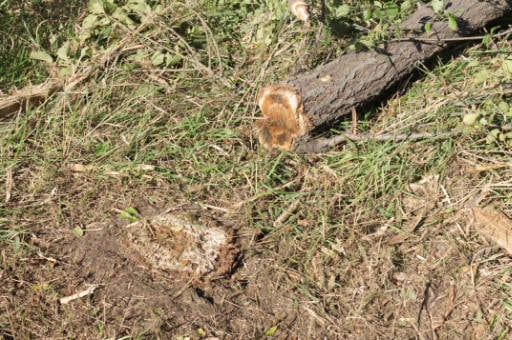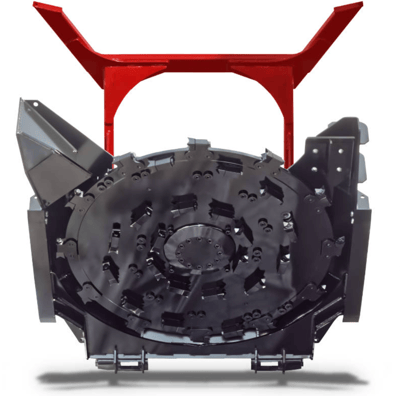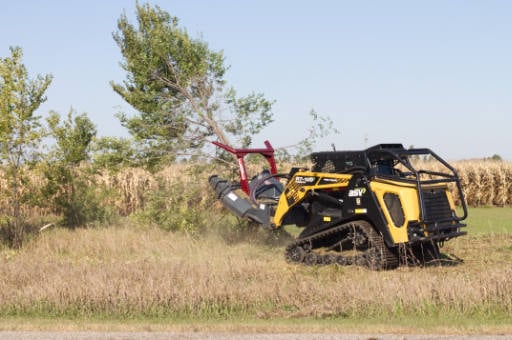What’s the difference between a skid steer disc mulcher and drum mulcher attachment? It’s a question we’re consistently being asked since we introduced the V70 Tree Disc Mulcher in early 2020. In this article, I discuss performance, costs, options, and other differences between these two skid steer mulchers to help you decide if either is right for you.
Looking for an easy way to compare options? Check out our easy-to-read comparison chart.
SKID STEER MULCHER APPLICATIONS
Mulching can be a profitable service for forestry and landscaping professionals. Here are the most common applications where skid steer mulchers are being used today:
- Land clearing for private and public property
- Site preparation and lot clearing
- Pipeline and transmission line maintenance
- Forest management and wildfire prevention
- Trail and road overgrowth clearing
- Storm damage and disaster cleanup
SKID STEER MULCHER PERFORMANCE
When choosing a skid steer mulcher attachment, it’s important to make sure it matches the machine’s capabilities to ensure it can operate efficiently. The machine needs to have the proper flow rate and be able to handle the weight of the attachment. Below, I discuss cutting capacity and capabilities of each skid steer mulcher.
Cutting Capacity
Skid steer disc mulchers have a larger cutting capacity. You’ll typically see a cutting capacity of 14” diameter trees. For drum mulchers, you’ll typically see an 8” or 9” capacity. “High flow skid steer drum mulchers will cut 8” diameter trees continuously. Operators can cut bigger trees than that, but it’s not advised. It doesn’t make sense to mulch any material larger than 8”, because it takes too much time. It helps to have someone go in beforehand to cut down the bigger trees and remove them before going in with the mulcher,” said Craig Erpelding, from US Equipment Broker.

Tree Clearing Methods & Productivity
Disc mulchers have the ability to pull whole trees into the deck, mulching them to pieces within a few seconds. Lastly, the stump can be mulched to the ground.
Both types of mulchers are able to cut the tops off taller trees. Then the operator can mulch the stump to ground level. Lastly, the top of the tree can be mulched while lying on the ground. Another similar technique is cutting a tree near the bottom and try to mulch the tree on the ground. This is a safer but more time-consuming method.
A disc is more difficult to bog down than a drum. Virnig's 900 lb disc and bent axis piston motor helps power through thick brush and 14" diameter trees with ease. Overall, trees can be cleared a lot quicker, which results in higher productivity when compared to a drum mulcher.
Mulching Stumps
Disc mulchers will grind stumps to ground level and drum mulchers can mulch stumps below ground. Erpelding said, “The biggest difference here is you can mulch 1-2” into the ground with a drum mulcher, allowing you to mulch stumps and roots below grade. You can even plant right into it afterward because it’s bringing up the topsoil and mulching the material into it.”
Final Finish
Do you want more wood chips or wood chunks? A drum mulcher leaves smaller wood chips while the disc mulcher leaves larger chunks when mulching. Disc mulchers can leave a fine mulch finish, but the operator will have to process the material again. Try to keep the teeth off the ground and avoid rocks to prevent wear.
SKID STEER MULCHER COSTS & OPTIONS
Disc mulcher skid steer attachments are less expensive. Most high flow disc mulchers fall into a $22,000-$32,000 price range and have a 60” cut width, while most high flow drum mulchers fall into a $33,000-$43,000 price range and have a 50”-75” cut width. Pricing will vary depending on width, the manufacturer chosen and the different options discussed below.
Skid Steer Disc Mulcher Options
 The motor is the most expensive part of the mulcher, and they either have a piston motor or a gear motor. Gear motors are usually a few thousand dollars less upfront, but productivity and efficiency will be sacrificed. A piston motor is the highest performing motor available. It will have quicker recovery time, higher disc speed and more torque than a gear motor. We only use bent-axis piston motors on the V70 Tree Disc Mulcher to deliver more torque and the disc spinning while other mulchers may bog down or stall.
The motor is the most expensive part of the mulcher, and they either have a piston motor or a gear motor. Gear motors are usually a few thousand dollars less upfront, but productivity and efficiency will be sacrificed. A piston motor is the highest performing motor available. It will have quicker recovery time, higher disc speed and more torque than a gear motor. We only use bent-axis piston motors on the V70 Tree Disc Mulcher to deliver more torque and the disc spinning while other mulchers may bog down or stall.
Quadco® four-sided steel teeth come standard on the V70 Tree Disc Mulcher. These teeth can be resharpened and are rotatable and replaceable. They will cut wood more efficiently than carbide since they are sharper and more aggressive. We don’t offer carbide teeth for the Disc Mulcher at this time.
PRO TIP: Keep teeth sharp to allow a clean, efficient cut. Keeping the teeth sharp will be easier on the machine and the mulcher motor. If the teeth are dull it will tear and shred material rather than cutting through it like butter.
Skid Steer Drum Mulcher Options
A drum mulcher attachment will either have a variable (two) speed piston motor or a gear motor. The piston motor will have quicker recovery time and provide more torque. The piston motor automatically changes the rotor speed and torque depending on the material being cut.
When rotor speed is high, material will shred faster and produce a finer end result. When in thicker material, the mulcher will provide more torque, while a different motor may stall. “When mulching dense material, the motor will automatically shift to a lower speed and for lighter material it will shift to a higher speed,” said Erpelding.
There are three different drum options in this industry - smooth, paddle style and depth control. “The depth control drum has metal rings around it which prevents it from going into the ground and will work best with knives,” said Erpelding.
There are also two main tooth options - knife and carbide. These will allow users to make different styles of cuts depending on application. “The right tooth combination depends on the material you’re mulching. What’s nice with a drum mulcher is you can run all carbide, all knife or 50/50 knife and carbide or any combination you want. Knives are about 2-3x cheaper than carbide,” said Erpelding.
TOOTH MAINTENANCE
Most of the maintenance time goes toward maintaining the teeth. “Most people run carbide on drum mulchers to start. Then they switch to steel knives, since knives are about 2-3x cheaper than carbide,” said Erpelding.
The steel teeth on most disc mulchers, including the V70 Tree Disc Mulcher, can be rotated and resharpened, resulting in a longer service life.

DEBRIS CONTAINMENT/SAFETY
Drum mulchers are generally safer to use in urban areas. “They will push most of the material back toward the ground and not away from it, like a disc mulcher,” said Erpelding. Some drum heads will have a door or deflector that will help push material toward the ground.
Disc mulcher exhaust will mainly come from the front and larger material will be tossed further than a drum mulcher. No matter where mulchers are operating, it’s always best to keep bystanders 300' away from all mulching attachments during operation to prevent injury.
Debris, rocks and chips will ricochet toward the operator. For operator safety, all mulcher manufacturers require installing shatterproof cab windows and some advise using a falling object protection system (FOPS) for operator safety.
MOTOR ADJUSTMENT
Many skid steer drum mulcher motors will need to be physically tuned by the attachment owner, manufacturer or dealer before operation. It must match the GPM (flow rate) of the loader and the optimal RPM of the mulcher rotor. Each manufacturer has their own guidelines and charts to help tune the mulcher to the skid steer.
This step is crucial because low RPM will result in slow, inefficient cut speeds, while higher RPM may permanently damage the motor. “I can set up customers with a mulcher right from the factory, so they have the right couplers, and motor is tuned correctly,” said Erpelding.
A skid steer disc mulcher works with a variety of high flow loaders without needing to adjust the mulcher motor each time a loader with a different flow rate is used. Attach the disc mulcher to the loader, connect couplers and the operator is ready to mulch.
MANEUVERABILITY & VISIBILITY
Drum mulchers have a slight advantage for both maneuverability and visibility. They’re more compact than a disc mulcher. The depth is similar to a dirt bucket which allows better maneuverability. For drum mulchers, operators can see exactly when the drum is hitting the ground and there isn’t a 60" deck limiting the operator’s view.
DISC MULCHER VS DRUM MULCHER CONCLUSION
Skid steer mulchers are great at performing in areas they're best suited for. Instead of one being better than the other, each style has its own advantages that will aid in some applications more than others. The more you know about your application and your desired end result, the easier it will be to choose a skid steer mulcher for your operation.
If you’re interested in learning more about Virnig skid steer brush cutters and mulchers, check out The Ultimate Guide to Skid Steer Brush Cutters. It’s full of helpful tips and information for getting the most out of a cutter.
Disc Mulcher vs. Drum Mulcher Comparison Chart
Disc Mulcher |
Drum Mulcher |
Cutting Capacity |
|
| 14” diameter trees | 8”-9” diameter trees |
Cutting Width |
|
| Usually 60” | Between 50”-75” |
Methods of Operation |
|
|
|
Final Finish |
|
| Leaves larger wood chunks | Leaves smaller wood chips |
Cost |
|
| $22-32k | $33-43k |
Options |
|
|
|
Debris Containment/ Safety |
|
| Not as safe for populated areas, will push material away from the attachment | Safer for populated areas, will push material back toward the ground |
Motor Adjustment |
|
| Works with most loaders without tuning | Motor needs to be tuned to both the rotor and loader’s specs. |
Maneuverability/ Visibility |
|
| Lower maneuverability and visibility | Higher maneuverability and visibility |
If you enjoyed this blog post, it's been rewritten and extended with a lot more helpful information here: Drum Mulcher vs. Disc Mulcher | The Ultimate Comparison.

